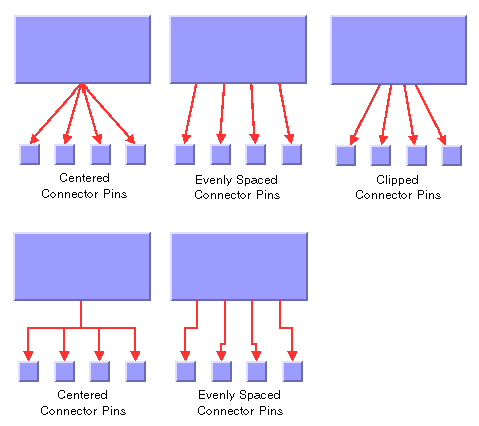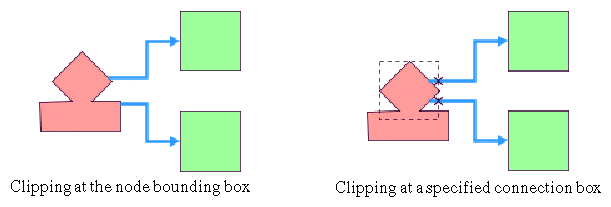The layout algorithm automatically positions
the end points of links (the connector pins) at the nodes. The
connector style parameter specifies how these end points are
calculated for the outgoing links at the parent node.
By default, the connector style determines
how the connection points of the links are distributed on the
border of the bounding box of the nodes, symmetrically with respect
to the middle of each side.

Connector styles
To specify the connector style:
In CSS
Add to the
GraphLayout
section:
connectorStyle: "CLIPPED_PINS";
In Java
Use the method:
void setConnectorStyle(int style);
The valid values for
style
are:
IlvTreeLayout.CENTERED_PINSThe end points of the links are placed in the center of the border where the links are attached.IlvTreeLayout.CLIPPED_PINSEach link pointing to the center of the node is clipped at the node border. The connector pins are placed at the points on the border where the links are clipped. This style affects straight links. It behaves like centered connector pins for orthogonal links.IlvTreeLayout.EVENLY_SPACED_PINSThe connector pins are evenly distributed along the node border. This style works for straight and orthogonal links.IlvTreeLayout.AUTOMATIC_PINSThe connector style is selected automatically depending on the link style and the layout mode. In nonradial modes, the algorithm always chooses centered pins. In radial layout modes, it chooses clipped pins.
In CSS, you omit the prefix
IlvTreeLayout
when specifying the value of the connector style.
Note
The connector style parameter requires link connectors at the
nodes of an IlvGrapher that allow connector pins to be
placed freely at the node border. It is recommended that you use
IlvFreeLinkConnector for link connectors
to be used in combination with
IlvGrapher
objects. If you use a diagram component, the free link
connectors are automatically installed when needed, unless
specified differently.
The connector style, the link connection
box interface, and the link clip interface work together in the
following way: by applying the connector style, the proposed
connection points are calculated on the rectangle obtained from
the link connection box interface (or on the bounding box of the
node, if no link connection box interface was specified). Then,
the proposed connection point is passed to the link clip
interface and the returned connection points are used to connect
the link to the node.
The following figure shows an example of
the combined effect.
If the links are clipped at the pink node
in the figure (left), they appear unsymmetrical with respect to
the node shape, because the relevant part of the node (here: the
upper rhombus) is not in the center of the bounding box of the
node, but the proposed connection points are calculated with
respect to the bounding box.

Combined effect of clipping and link
connection box
It can be corrected by using a link
connection box interface to explicitly specify a smaller connection
box for the relevant part of the node (previous figure, right) such
that the proposed connection points are placed symmetrically at the
upper rhombus of the node.